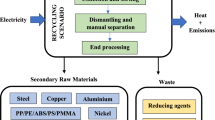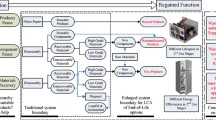Abstract
Background, Aims and Scope
Telecommunication and information technology, dramatically emerged during the last decade, has generated environmental problems by accelerating mass production, mass consumption, and mass disposal of personal computers (PCs) in Korea. In addition, it has led the Korean new economy. The Korean government has encouraged researchers and industry to study the environmental impact, adequate disposal treatment, and the reasonable recycling rate of an end-of-life personal computer. The main purpose of this research is to investigate the life cycle environmental impact of PCs and to determine the desirable or feasible recycle rate of an end-of-life PC. An LCA on a PC was performed based on different recycling scenario. Target audiences are new product developers, designers, product recovery managers and environmental policy makers who are interested in the environmental impact of PCs and recycling of end-of-life products.
Methods
A target product is a Pentium IV personal computer made in Korea in 2001, excluding the monitor and peripheral equipment. The procedure of the LCA followed the ISO14040 series. System boundary includes the entire life cycle of the product, including pre-manufacturing (the electrical parts and components manufacturing), manufacturing, transportation, use, and disposal. The LCI and impact assessment database for a PC was constructed using SIMAPRO version 4.0 software and LCI information was compiled by site-specific data and the Korean national database. The LCA was performed on different recycling scenarios: one being that of the current recycling rate of 46%, and the other being the ideal condition of a 100% recycling rate.
Results and Discussion
Abiotic depletion, global warming, ecotoxicity, human toxicity, acidification, ozone layer depletion, photo-oxidant formation, and eutrophication are adopted as the impact categories. The pre-manufacturing stage was a significant stage for all of the environmental parameters, besides human toxicity potential. PC manufacturing consists of rather simple processes such as assembly and packaging. For improving the environmental performance of PCs, environmental management approaches of design for the environment and green procurement are recommended. The use stage had a significant potential due to the electricity consumption produced by burning fossil fuel. The disposal stage's contribution to environmental impact was largest in human toxicity, and second largest in ozone layer depletion potential. The PC recycling was shown to inhibit all environmental impacts with the exception of the ozone depletion and ecotoxicity potential. The increase of light oil, nitric acid, sulfuric acid, and deoxidating agent consumption during the recycling process contributes to the environmental impact of ozone and ecotoxicity parameters. Current recovery and recycling technologies should be taken into account for enhancing the benefits of recycling. Anyway, the effectiveness of recycling was highlighted by this study. PC recycling reduces the total environmental impact of the product. The PC recycling is recommended to be raised up to at least 63% in order to reduce the environmental burdens of a PC in other life cycle stages.
Conclusion and Recommendation
This study implies that design for the environment (DfE) in the product design stage and green procurement are recommended for improving the entire environmental performance of electronic equipment such as PCs. The recycling of waste PCs clearly reduces the environmental burden. There are, however, trade-offs among environmental parameters according to the PC recycling rate. Current recycling methods are not effective in reducing ozone depletion and ecotoxicity environmental impact. The product recovery is another key for efficient recycling. Efficient reverse logistics to collect and transport end-of-life PCs should be taken into account to enhance recycling effects. There were several electrical parts not included in this assessment, due to the unavailability of adequate data. Further studies with more detail and reliable inventories for electrical parts and sub-components are recommended. Furthermore, costs of recycling should also be treated in further research.
Similar content being viewed by others
Author information
Authors and Affiliations
Corresponding authors
Rights and permissions
About this article
Cite this article
Choi, BC., Shin, HS., Lee, SY. et al. Life Cycle Assessment of a Personal Computer and its Effective Recycling Rate (7 pp). Int J Life Cycle Assessment 11, 122–128 (2006). https://doi.org/10.1065/lca2004.12.196
Received:
Accepted:
Published:
Issue Date:
DOI: https://doi.org/10.1065/lca2004.12.196




